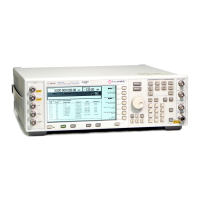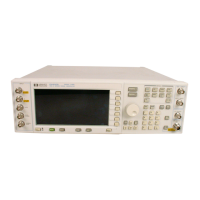38 Chapter 2
E4438C Vector Signal Generator Overview
Rear Panel Overview
1. 321.4 IN Connector (Option 300)
Use this female SMB connector to input a downconverted 321.4 MHz GSM/EDGE signal for base
transceiver station (BTS) loopback measurements. (Option 300 also requires Options UN7, 001/601or
002/602, and 402).
2. BER GATE IN Connector (Option UN7)
Use this female SMB connector to input the clock gate signal for the bit-error-rate measurements. The clock
signal to the BER CLK IN connector is valid only when the signal to this connector is a high or low,
depending on your softkey selection or SCPI command. The d
amage levels are > +5.5 volts and < −0.5 volts.
This connector accepts a high impedance TTL-compatible signal or a 75Ω input. It can be enabled or
disabled by a softkey or a SCPI command.
3. BER CLK IN Connector (Option UN7)
Use this female SMB connector to input the clock signal for the bit-error-rate measurements. The rising
(positive) or falling (negative) edge of the signal (selected either by softkey or SCPI command) causes data
on the BER DATA IN connector to be sampled. The d
amage levels are > +5.5 volts and < −0.5 volts. This
connector accepts a high impedance TTL-compatible signal or a 75Ω input.
4. BER DATA IN Connector (Option UN7)
Use this female SMB connector to input the data streams for the bit-error-rate measurements. The rising
(positive) or falling (negative) edge of the BER CLK IN signal (selected by the softkey or the SCPI
command) is used to trigger the reading of the data. The d
amage levels are > +5.5 volts and < −0.5 volts. This
connector accepts a high impedance TTL-compatible signal or a 75Ω input.
5. I-bar OUT Connector (Option 001/601 or 002/602)
This female BNC connector is used in conjunction with the I OUT connector to provide a balanced baseband
stimulus. Balanced signals are signals present in two separate conductors that are symmetrical relative to
ground, and are opposite in polarity (180 degrees out of phase). The nominal output impedance of this
connector is 50Ω, DC-coupled. The damage levels are > +2 V and < −2 V. The DC origin offset is typically
< 10 mV. The output signal levels into a 50Ω load are as follows:
• 0.5 V
pk
, typical, corresponds to one unit length of the I/Q vector.
• 0.69 V
pk
(2.84 dB), typical, maximum crest factor for peaks for π/4 DQPSK with alpha = 0.5.
• 0.71 V
pk
(3.08 dB), typical, maximum crest factor for peaks for π/4 DQPSK with alpha = 0.35.
• Typically 1 V
p-p
maximum (Option 001/601or 002/602 only).

